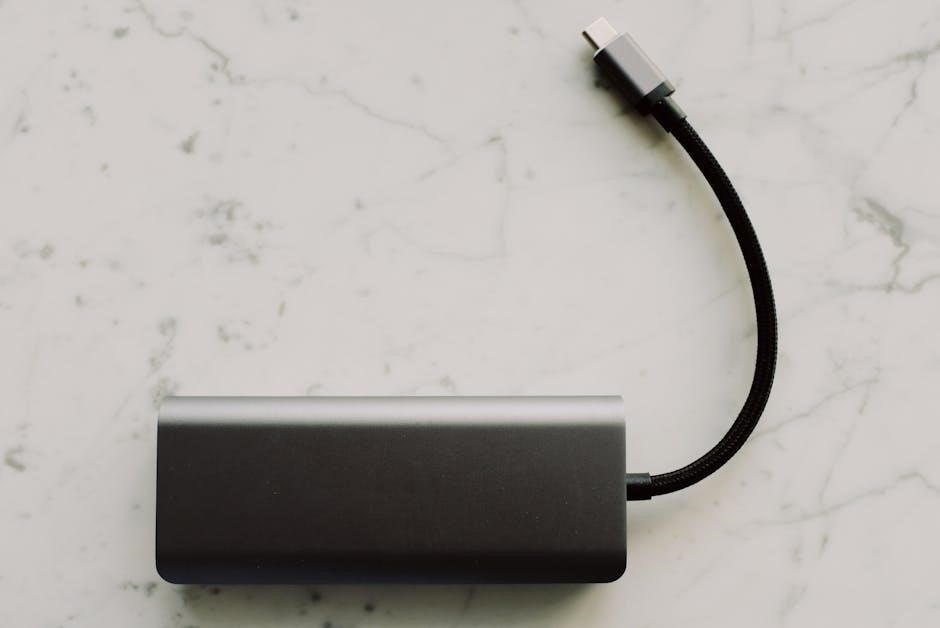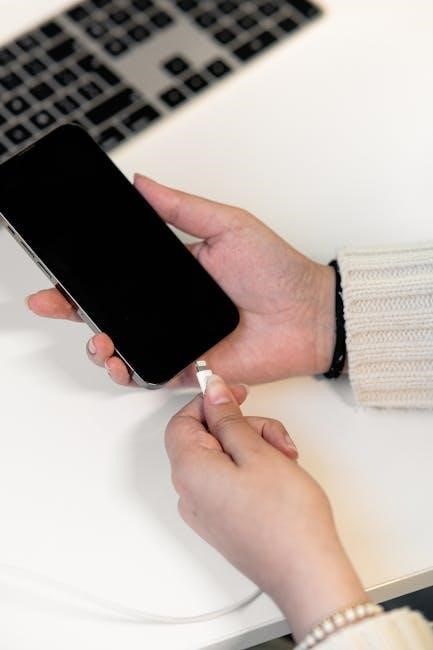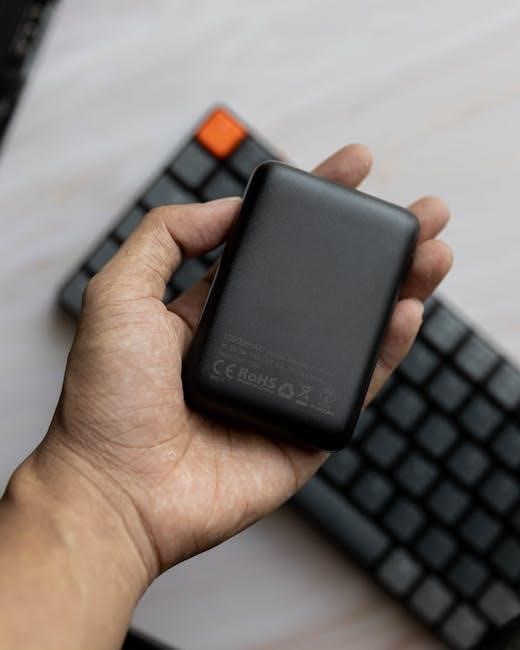
rohs battery charger instructions
RoHS Battery Charger Instructions: A Comprehensive Guide
This guide provides essential instructions for safely and effectively using RoHS compliant battery chargers.
It covers compatibility, charging steps, and troubleshooting, ensuring optimal performance while adhering to
RoHS standards. Understanding these guidelines maximizes the lifespan of your batteries and chargers.
Understanding RoHS Compliance
RoHS compliance is crucial for battery chargers, ensuring they meet environmental and safety standards by
restricting hazardous substances. The RoHS directive, originating in the European Union, limits the use of
materials like lead, mercury, cadmium, and hexavalent chromium. This compliance extends to all applicable
products on the EU market since July 1, 2006, and involves manufacturers sourcing certified components.
RoHS 2, known as Directive 2011/65/EU, requires CE marking for compliant products and adds categories and
recordkeeping needs. Understanding RoHS ramifications is vital for manufacturers worldwide, affecting power
supply production. Power Sonic A-C battery chargers bear the RoHS mark, indicating adherence to these
directives. Compliance assurance ensures products meet stringent safety and quality benchmarks, promoting
environmental health.
Checking for RoHS markings and certifications verifies compliance, allowing consumers and businesses to make
informed decisions about their products. Manufacturers must use RoHS-compliant materials and processes to
produce components such as battery cells, terminals, and casings. RoHS compliance is more than just
collecting documents; it requires thorough evaluation and adherence to EN 63000:2018 standards.

What is RoHS and Why is it Important?

RoHS, short for Restriction of Hazardous Substances, is a mandatory EU standard restricting the use of
certain dangerous materials in electrical and electronic equipment. The original RoHS, Directive 2002/95/EC,
aimed to reduce the environmental impact and health risks associated with these substances. RoHS compliance
is crucial because it ensures that products, including battery chargers, do not contain harmful chemicals like
lead, mercury, cadmium, and hexavalent chromium.
The importance of RoHS lies in its protection of both the environment and public health. By limiting these
hazardous substances, RoHS helps prevent pollution during manufacturing, recycling, and disposal processes.
This regulation also reduces the risk of exposure to toxic materials for workers and consumers. RoHS
compliance opens access to the EU market, as all applicable products must meet these standards.
Adhering to RoHS directives demonstrates a commitment to environmental responsibility and product safety. It
ensures that battery chargers and other electronic devices are designed and produced in a way that minimizes
harmful impacts. Compliance with RoHS regulations is not just a legal requirement but also a reflection of a
company’s dedication to sustainability and ethical practices.
RoHS Directive and Battery Chargers: Scope and Exclusions
The RoHS directive primarily targets electrical and electronic equipment, including battery chargers, to restrict
hazardous substances. Directive 2011/65/EU, also known as RoHS 2, expanded the scope and added categories,
requiring compliance for CE marking. The directive covers a wide array of products, from large household
appliances to smaller devices, ensuring that these items meet the necessary safety standards regarding
restricted materials.
However, the RoHS directive does have specific exclusions. Notably, cells and batteries themselves are
generally excluded due to the precedence of the EU Battery Directive 91/157/EEC, which mandates specific
recovery programs for batteries and battery assemblies. This Battery Directive aims to prevent harmful waste
streams. Therefore, while the battery charger must comply with RoHS, the battery it charges falls under a
different regulatory framework focused on recycling and disposal.
It’s important to note that while batteries are excluded, components within the battery charger must still
comply with RoHS. This includes materials used in the charger’s circuit boards, casings, and other parts.
Manufacturers ensure compliance by sourcing materials with RoHS certifications, verifying adherence to
standards. Understanding these distinctions is crucial for manufacturers and consumers alike.
Identifying RoHS Compliant Battery Chargers
Identifying RoHS compliant battery chargers involves several key steps to ensure that the product meets the
necessary safety and environmental standards. Look for the RoHS marking, which, although not an official
compliance mark, is commonly used to indicate that the product adheres to the RoHS directive. This marking
suggests that the charger does not contain restricted hazardous substances above the allowable limits.
Check for certifications from recognized testing laboratories. These certifications verify that the charger has
undergone testing and meets RoHS requirements. Additionally, examine the product documentation and
specifications provided by the manufacturer. Reputable manufacturers often include detailed information about
RoHS compliance in their product manuals or on their websites. Look for statements confirming adherence to
Directive 2011/65/EU or later amendments.
Verify the materials used in the charger’s construction. RoHS compliant chargers use components that have been
tested and certified to be free of restricted substances like lead, mercury, cadmium, and hexavalent chromium.
Ensure that the product packaging or labeling clearly states compliance with RoHS standards. By carefully
evaluating these factors, you can confidently identify and select RoHS compliant battery chargers, contributing
to a safer and more environmentally responsible choice.
Checking for RoHS Markings and Certifications
When verifying a battery charger’s compliance with RoHS (Restriction of Hazardous Substances) standards, checking
for the appropriate markings and certifications is crucial. The RoHS marking, often a simple logo, indicates
that the product complies with the RoHS directive, limiting the use of specific hazardous materials like lead,
mercury, and cadmium. However, it’s important to note that this marking alone does not guarantee compliance.
Look for certifications from accredited testing laboratories, such as CE, UL, or TÜV, which signify that the
charger has undergone rigorous testing and meets the necessary safety and environmental requirements. These
certifications typically involve thorough evaluation of the product’s materials and manufacturing processes.
Examine the product’s documentation, including manuals and datasheets, for explicit statements of RoHS
compliance and references to relevant standards like Directive 2011/65/EU.
Manufacturers committed to RoHS compliance will provide detailed information about the materials used and the
testing conducted. Cross-reference the certification marks with the issuing body’s online database to confirm
their validity. Be wary of counterfeit markings or certifications. By meticulously checking for RoHS markings and
verifying certifications, consumers and businesses can ensure they are purchasing battery chargers that adhere
to environmental regulations and minimize the risk of hazardous substance exposure.
Safe Charging Practices for RoHS Compliant Power Banks
To ensure the longevity and safety of your RoHS compliant power banks, adopting safe charging practices is
essential. Always use the original charger or a certified charger that meets the power bank’s voltage and
current requirements. Avoid using damaged chargers or cables, as they can lead to overheating or electrical
hazards. Before charging, inspect the power bank for any signs of damage, such as swelling or leakage.
Charge the power bank in a well-ventilated area, away from flammable materials and direct sunlight. Do not
cover the power bank while charging, as this can trap heat. Disconnect the power bank from the charger once it
is fully charged to prevent overcharging, which can reduce its lifespan. Avoid leaving the power bank
unattended for extended periods while charging. Store the power bank in a cool, dry place when not in use.
Never disassemble or modify the power bank, as this can compromise its safety features and void the warranty.
If you notice any unusual behavior, such as excessive heat, strange noises, or smoke, immediately disconnect
the power bank and contact the manufacturer. By following these safe charging practices, you can maximize the
performance and lifespan of your RoHS compliant power bank while minimizing the risk of accidents or damage.
Ensuring Compatibility and Voltage Matching
Before charging any device with a RoHS compliant battery charger, ensuring compatibility and proper voltage
matching is crucial for safety and optimal performance. Always check the voltage and current requirements of
both the device being charged and the charger itself; These specifications are typically printed on the device
and charger labels. Using a charger with an incorrect voltage can damage the device or pose a safety hazard.
Voltage matching is paramount; using a charger with a higher voltage than the device requires can cause
overheating, battery damage, or even fire. Conversely, using a charger with a lower voltage may not
adequately charge the device or could result in prolonged charging times. In addition to voltage, consider
the current (amperage) rating. A charger with a higher current rating than required is generally safe, as
the device will only draw the necessary current.
However, using a charger with a lower current rating may result in slow charging or prevent the device from
charging altogether. Always prioritize using the charger that came with the device or a certified charger
recommended by the manufacturer. If using a universal charger, carefully verify that the voltage and current
settings are correct before connecting it to the device. Consulting the device’s user manual can provide
valuable information on compatible chargers and voltage requirements, preventing potential damage and ensuring
safe charging practices.

Step-by-Step Charging Instructions
To safely and effectively charge your devices using a RoHS compliant battery charger, follow these step-by-step
instructions. First, carefully inspect both the charger and the device for any signs of damage, such as frayed
cords, loose connections, or cracks. If any damage is detected, do not use the charger and seek a replacement.
Next, ensure that the voltage and current ratings of the charger match the requirements of the device you are
charging. Refer to the device’s user manual or the label on the device itself to confirm these specifications.
Once you have verified compatibility, plug the charger into a grounded power outlet. Avoid using extension cords
or power strips, as these can sometimes cause voltage fluctuations or overheating. Connect the charger to the
device, ensuring a secure and stable connection. Observe the charging indicator on the device to confirm that
charging has commenced. If the device does not begin charging, double-check the connections and the power
outlet.

Allow the device to charge fully, but avoid overcharging, as this can damage the battery. Once the device is
fully charged, disconnect it from the charger and unplug the charger from the power outlet. Store the charger
in a cool, dry place away from direct sunlight and extreme temperatures. Regularly inspect the charger for any
signs of wear and tear, and replace it if necessary. By following these instructions, you can ensure safe and
efficient charging of your devices while adhering to RoHS guidelines.
Troubleshooting Common Charging Issues
Even with RoHS compliant battery chargers, charging issues can sometimes arise. If your device isn’t charging,
first verify the power source. Ensure the outlet is functioning by testing it with another device. Check the
charger’s connection to both the outlet and your device; a loose connection is a common culprit. Inspect the
charging cable for any visible damage, such as frays or bends, which could impede the flow of electricity.
Try a different cable to rule out cable malfunction.
If the power source and cable are fine, examine the charging port on your device for debris or damage. Use a
small brush or compressed air to gently clean the port. A damaged charging port may require professional
repair. If your device charges intermittently, it could indicate a battery issue. Consider testing the battery
in another compatible device or consulting a technician to assess battery health. Overheating during charging
is another concern. Ensure the charger and device are placed on a well-ventilated surface, away from direct
sunlight or heat sources.
If overheating persists, discontinue use and allow the devices to cool down. A faulty charger can also cause
charging problems. Test your device with a different charger known to be working. If the device charges
successfully with another charger, the original charger is likely defective and should be replaced. Remember
to always use RoHS compliant chargers to ensure safety and environmental compliance.
RoHS Compliance Verification
Verifying RoHS compliance of battery chargers is crucial to ensure they meet environmental standards and don’t
contain restricted hazardous substances. Start by visually inspecting the charger for the RoHS marking, typically
a “CE” mark followed by “RoHS.” This indicates the manufacturer claims compliance. However, a visual
inspection alone isn’t sufficient for complete verification.
Request a Declaration of Conformity (DoC) from the manufacturer or supplier. This document should state which
RoHS directive the product complies with (e.g;, 2011/65/EU, also known as RoHS 2). The DoC should also list
the restricted substances and confirm that their levels are below the permissible limits. For more rigorous
verification, request test reports from accredited testing laboratories. These reports provide detailed analysis
of the materials used in the charger, confirming the absence or presence of restricted substances like lead,
mercury, cadmium, hexavalent chromium, polybrominated biphenyls (PBBs), and polybrominated diphenyl ethers
(PBDEs).
Ensure the test reports are recent and relevant to the specific model of the battery charger. If you’re a
manufacturer incorporating battery chargers into your products, maintain records of all compliance
documentation, including DoCs and test reports, for at least ten years, as required by RoHS 2. Regularly
audit your suppliers to ensure ongoing compliance and perform periodic testing to confirm the accuracy of
their claims.